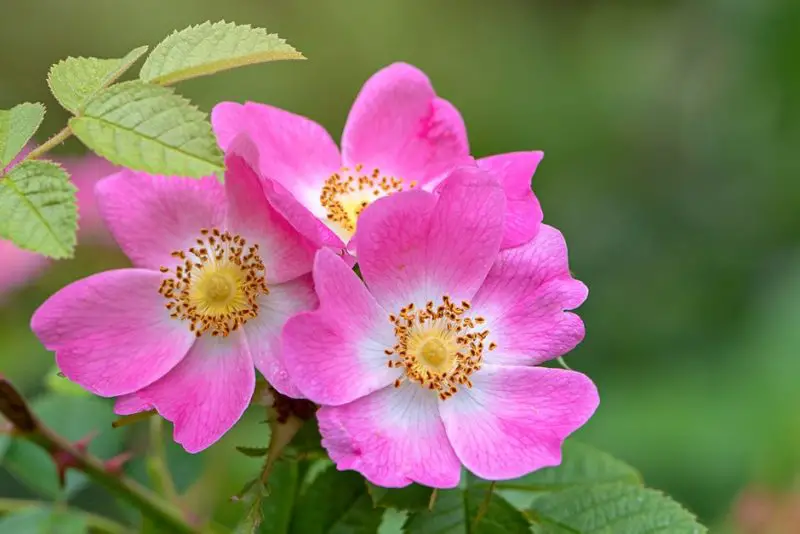Wild roses bring an irresistible charm to any garden with their delicate petals and soft fragrance. Unlike cultivated varieties, they flourish naturally, requiring minimal care while adding a touch of untamed beauty. Their resilient nature allows them to thrive in diverse climates and soils, making them perfect for both novice and seasoned gardeners.
Beyond their aesthetic appeal, wild roses support local ecosystems. Bees and butterflies are drawn to their blooms, while birds find shelter in their dense thickets. Growing wild roses not only enhances your garden’s visual appeal but also nurtures biodiversity, creating a harmonious balance between beauty and nature.
Choosing the Right Location for Wild Roses

Selecting the right location is essential for wild roses to flourish. Sunlight plays a critical role in promoting vibrant blooms and strong growth. Ideally, wild roses should receive at least six hours of direct sunlight daily. Morning sun is particularly beneficial because it dries dew quickly, reducing the risk of fungal diseases. Choosing a sunny spot ensures the plants produce abundant flowers and maintain healthy foliage throughout the growing season.
Soil quality is another vital factor. Wild roses prefer well-draining soil enriched with organic matter like compost or aged mulch. Soil that retains too much water can cause root rot and weaken the plants. Slightly acidic to neutral soil with good fertility allows the roses to absorb essential nutrients efficiently. Before planting, gardeners should test the soil and amend it if necessary, ensuring the environment supports strong root development and vibrant flowering.
Proper spacing is equally important for thriving wild roses. These plants naturally spread and can form dense clusters over time. Giving each plant enough space improves air circulation and reduces the risk of disease. It also allows sunlight to reach lower branches, promoting even growth and more flowers. By carefully choosing a sunny, well-draining, and spacious location, gardeners create the ideal conditions for wild roses to grow vigorously. A thoughtfully selected site sets the foundation for a beautiful and sustainable wild rose garden that blooms year after year.
Preparing the Soil for Planting Wild Roses
Proper soil preparation is essential for wild roses to grow healthy and bloom abundantly. Begin by clearing the planting area of weeds, rocks, and debris. Removing these obstacles ensures that roots can expand freely and establish quickly. A clean site also reduces competition for nutrients and water, giving new plants a strong start. Ensuring the area is level helps prevent water from pooling around the roots, which can cause rot and disease.
Next, improve soil fertility by incorporating organic matter. Compost, well-rotted manure, or leaf mold enhances soil structure and nutrient content. Work these materials into the top 12 inches of soil to promote healthy root development and better moisture retention. Well-draining soil prevents waterlogging, which can harm roots. If your soil is heavy clay or sandy, mix in organic amendments to balance texture. Properly enriched soil supports vigorous growth, stronger stems, and more abundant flowers.
Finally, test and adjust soil pH for optimal results. Wild roses thrive in slightly acidic to neutral soil, ideally between 6.0 and 7.0. Conducting a soil test allows gardeners to identify deficiencies or imbalances. Apply lime to raise pH or sulfur to lower it, ensuring nutrient availability. Correct pH enhances flower quality, foliage health, and overall plant vigor. By preparing the soil thoroughly, gardeners set the stage for resilient, vibrant wild roses. Well-prepared soil is the foundation for a thriving garden that produces consistent blooms season after season.
Planting Wild Roses Successfully
Planting wild roses at the correct depth is essential for healthy growth and long-lasting blooms. Begin by digging a hole twice as wide as the plant’s root ball. This provides ample space for roots to spread naturally. Place the rose so that the graft union sits slightly above the soil surface. Backfill gently to remove air pockets, ensuring roots have firm contact with the soil. Proper planting depth prevents waterlogging and supports strong initial growth.
Watering immediately after planting helps the soil settle around roots and reduces transplant shock. A deep soak encourages roots to grow downward, establishing stability. Applying a layer of mulch around the base conserves moisture, regulates soil temperature, and suppresses weeds. Keep mulch a few inches away from the stem to avoid rot. Regular watering during the first few weeks is critical for young plants to develop a strong root system.
Timing also affects planting success. Early spring or fall is ideal when temperatures are moderate, avoiding extreme heat or frost. Select healthy, disease-free plants for higher survival rates. Proper handling during planting minimizes damage to roots and stems. By following these careful steps, gardeners give wild roses the best start. Well-planted roses grow vigorously, produce abundant blooms, and form a resilient garden feature. Proper planting is the foundation for a thriving wild rose garden that delights year after year with natural beauty.
Watering and Caring for Wild Roses
Proper Watering for Wild Roses
Proper watering is essential for wild roses to develop strong roots and healthy foliage. Newly planted roses need deep, consistent watering. Watering at the base encourages roots to grow downward, promoting stability and drought resilience. Shallow watering often leads to weak surface roots, making plants more vulnerable to heat and dry conditions. Monitoring soil moisture ensures the roses receive enough water without overwatering.
Morning watering is the best practice because it reduces evaporation and allows leaves to dry throughout the day. Wet foliage overnight increases the risk of fungal diseases such as black spot or powdery mildew. Mulching around the base helps retain soil moisture and regulate temperature, reducing the frequency of watering. Drip irrigation or soaker hoses deliver water efficiently to roots without wetting leaves. Maintaining consistent moisture supports vigorous growth, abundant blooms, and long-lasting garden beauty. With proper watering practices, wild roses flourish throughout the season.
Routine Care and Maintenance
Regular care is key to keeping wild roses healthy and blooming continuously. Pruning dead or damaged branches improves airflow, reduces disease risks, and encourages new growth. Fertilizing during the growing season supplies essential nutrients for strong stems and vibrant flowers. Organic compost, well-balanced chemical fertilizers, or slow-release formulas all help nourish the plants effectively.
Monitoring for pests like aphids, spider mites, or fungal infections is crucial. Early detection and treatment minimize damage and maintain plant vigor. Applying mulch conserves soil moisture, suppresses weeds, and regulates temperature. Keep mulch a few inches away from stems to avoid rot. Seasonal pruning after flowering shapes the plant and encourages more blooms. By combining watering, pruning, fertilizing, mulching, and pest management, gardeners create ideal conditions for wild roses. Healthy, well-cared-for plants reward effort with vibrant flowers and lush foliage.
Pruning Techniques for Wild Roses
Pruning wild roses is essential for maintaining plant health and encouraging abundant blooms. Start by removing dead, diseased, or damaged branches. This prevents the spread of disease and allows more sunlight and air to reach healthy stems. Pruning also helps shape the plant, keeping it manageable and visually appealing. Use clean, sharp pruning shears to make precise cuts and reduce stress on the plant. Regular pruning ensures stronger growth and promotes vibrant flower production throughout the season.
Timing is crucial when pruning wild roses. Early spring is ideal for removing winter-damaged wood and stimulating new growth. Light pruning after flowering can encourage a second bloom and maintain the plant’s shape. Avoid heavy pruning during extreme heat or frost, as it can stress the plant and reduce flowering potential. Observe the natural growth habit and remove only the necessary branches to balance plant health with aesthetics. Proper timing supports both growth and continuous flowering.
Techniques also include thinning and heading cuts. Thinning removes entire stems at the base, improving airflow and light penetration. Heading shortens stems to encourage bushier growth and more flowers. Combine these techniques according to the plant’s size and desired shape. Always prune at an angle above a healthy bud or branch. By following proper pruning practices, gardeners maintain resilient wild roses with strong stems, abundant blooms, and a long lifespan. Regular care ensures a thriving garden full of naturally beautiful wild roses year after year.
Fertilizing and Soil Nutrition for Wild Roses
Choosing the Right Fertilizer
Selecting the right fertilizer is crucial for wild roses to thrive and produce vibrant blooms. Different fertilizers supply varying levels of nitrogen, phosphorus, and potassium, each affecting plant growth uniquely. Nitrogen promotes leafy growth, phosphorus encourages strong roots and flower development, while potassium improves overall plant health. Choosing a balanced fertilizer ensures the plant receives all essential nutrients for optimal growth.
Application timing is equally important. Fertilize wild roses in early spring when new growth begins, and again after the first bloom cycle to support continued flowering. Organic options such as compost, well-rotted manure, or fish emulsion provide slow-release nutrients and improve soil structure. Granular chemical fertilizers are effective when applied evenly around the base, avoiding direct contact with stems. Consistent, proper fertilization ensures strong stems, lush foliage, and abundant flowers. Regular monitoring prevents over-fertilization, which can damage roots and reduce flower quality.
Maintaining Soil Health
Healthy soil is the foundation for vigorous wild roses. Incorporating organic matter such as compost or leaf mold improves soil texture, fertility, and moisture retention. Well-amended soil allows roots to penetrate deeply, supporting steady growth and abundant blooms. Testing soil pH is also essential, as wild roses prefer slightly acidic to neutral soil, ideally between 6.0 and 7.0. Adjust pH with lime or sulfur as needed.
Mulching complements fertilization by conserving soil moisture, regulating temperature, and reducing weed competition. It also gradually adds nutrients to the soil as it decomposes. Avoid piling mulch against stems to prevent rot. Periodically aerating the soil encourages oxygen flow to roots and helps nutrient absorption. Maintaining soil health through proper nutrition and amendments ensures wild roses grow resiliently, produce vibrant flowers, and maintain long-term vitality. Healthy soil creates a thriving garden foundation for stunning seasonal displays.
Pest and Disease Management for Wild Roses
Common Pests and How to Control Them
Wild roses are susceptible to various pests, including aphids, spider mites, and Japanese beetles. Aphids feed on new growth, causing leaves to curl and weaken stems. Spider mites thrive in hot, dry conditions and leave tiny webs on foliage. Japanese beetles chew leaves and flowers, leaving unsightly damage. Identifying pests early is critical to prevent severe infestations. Regularly inspect plants, especially under leaves and at branch junctions, to catch problems promptly.
Control measures include manual removal, natural predators, and organic treatments. Ladybugs and lacewings feed on aphids and spider mites, reducing infestations naturally. Insecticidal soaps or neem oil can be applied carefully to affected areas. For Japanese beetles, handpicking or using pheromone traps helps protect plants without harming beneficial insects. Maintaining healthy, vigorous plants through proper watering, fertilization, and pruning makes them less vulnerable to pest attacks. Consistent monitoring and targeted action ensure wild roses remain strong and bloom abundantly.
Disease Prevention and Management
Fungal diseases such as black spot, powdery mildew, and rust frequently affect wild roses. Black spot appears as dark circular patches on leaves, causing premature leaf drop and weakened plants. Powdery mildew coats leaves and buds with a white, powdery layer, while rust produces orange pustules that reduce foliage health. Preventing these diseases begins with proper cultural practices. Maintain adequate spacing between plants and prune regularly to improve airflow. Avoid overhead watering, which keeps leaves wet and encourages fungal growth. Removing fallen leaves and plant debris also minimizes infection sources, keeping the garden cleaner and healthier.
Early detection and timely treatment are critical for controlling diseases. Remove and dispose of infected leaves immediately to prevent further spread. Apply fungicides as needed, following label instructions carefully to ensure effectiveness and safety. Selecting disease-resistant wild rose varieties reduces vulnerability to common fungal problems. Regularly disinfect pruning tools to prevent pathogen transfer between plants. Combining preventive measures, prompt intervention, and consistent care helps maintain healthy, resilient wild roses. Proper disease management ensures vibrant flowers, strong stems, and a thriving garden that continues to flourish season after season.
Winter Care and Protection for Wild Roses
Wild roses require extra attention during winter to survive frost and cold winds. Mulching around the base with straw, shredded leaves, or compost insulates roots, stabilizes soil temperature, and prevents frost heaving. Avoid piling mulch directly against stems to reduce rot risk. For climbing or taller roses, use burlap or frost cloths to protect above-ground branches. Tying branches together helps prevent wind damage and breakage. Proper insulation ensures roots remain healthy and ready for spring growth.
Pruning before winter removes dead, damaged, or diseased wood, reducing energy loss and minimizing pest habitats. Stop fertilizing at least six weeks before the first frost to avoid stimulating tender new growth. Watering should continue in moderation, ensuring soil does not completely dry out. Dry winter soil can damage roots, while overwatering increases the risk of fungal infections. Checking plants periodically during winter helps identify snow, ice, or rodent damage early, allowing timely intervention to protect stems and buds.
Additional protection techniques include using rose cones or temporary shelters in regions with extreme cold. Wrapping canes with burlap or tying them upright prevents breakage and minimizes frost exposure. Mulching combined with structural protection maintains soil warmth and conserves moisture. By implementing these winter care practices, gardeners preserve plant health, protect buds, and ensure vigorous growth when the growing season returns. Proper winter preparation supports abundant blooms, strong stems, and a resilient, long-lasting wild rose garden year after year.
Attracting Pollinators to Wild Roses
Wild roses are not only beautiful but also valuable for supporting pollinators. Bees, butterflies, and other beneficial insects are drawn to their fragrant blooms. Providing a consistent supply of flowers ensures pollinators visit regularly. Planting multiple wild roses together in sunny locations enhances visibility and access, making it easier for pollinators to find nectar and pollen. Diverse garden settings with companion plants further increase the attractiveness of the area.
Creating a pollinator-friendly environment involves more than planting roses. Avoid chemical pesticides that can harm bees and butterflies. Instead, use organic solutions or manual pest removal. Incorporate a variety of flowering plants that bloom at different times to provide a continuous nectar source. Native wildflowers near the roses help attract a wider range of pollinators. Additionally, leaving some natural habitat, such as undisturbed ground or small shrubs, gives shelter and breeding areas for beneficial insects. Healthy, diverse ecosystems increase pollination efficiency for your roses and other garden plants.
Maintaining wild roses properly also improves pollinator visits. Deadheading spent flowers encourages new blooms, extending the flowering season. Pruning enhances airflow and sun exposure, improving flower quality and scent. Regular watering and fertilization support vibrant, long-lasting blooms. By combining careful plant care with habitat-friendly practices, gardeners create an inviting environment for pollinators. A thriving pollinator population ensures robust fruiting and seed production while enhancing biodiversity. Ultimately, attracting pollinators to wild roses not only strengthens the garden’s ecological balance but also guarantees stunning displays of flowers throughout the growing season, benefiting both the plants and the ecosystem.
Propagation Techniques for Wild Roses
Propagating wild roses allows gardeners to expand their garden and preserve favorite varieties. One common method is through cuttings. Select healthy, disease-free stems in late spring or early summer. Cut 6-8 inch sections just below a node, removing lower leaves. Dip the cut end in rooting hormone to encourage root development. Plant the cutting in a well-draining soil mix, keeping it moist but not waterlogged. Covering with a plastic bag or propagator maintains humidity and improves rooting success.
Another effective propagation method is layering. Choose a low-growing, flexible branch and bend it gently to touch the soil. Wound the branch slightly where it contacts the ground, and secure it with a pin or small rock. Cover the wounded section with soil, leaving the tip exposed. Over several months, roots form at the buried section, after which it can be separated from the parent plant. Layering is a low-risk method that produces strong, well-established new plants.
Seed propagation is also possible, though it requires more patience. Collect rose hips after flowering and extract the seeds. Clean them and allow a period of cold stratification to mimic natural winter conditions. Sow seeds in a well-draining soil mix and keep them moist. Germination can take several weeks to months, depending on the variety. Combining these propagation techniques enables gardeners to grow new wild roses successfully. Proper care and patience ensure vigorous plants, abundant future blooms, and the continued beauty of a thriving wild rose garden.
Companion Plants for Wild Roses
Selecting suitable companion plants enhances the beauty and health of wild roses. Plants with complementary growth habits and bloom times create a visually appealing garden. Lavender, catmint, and salvia are excellent companions because they attract pollinators while repelling some pests. Their contrasting colors and textures highlight wild roses’ natural beauty. Grouping plants with similar sunlight and soil requirements ensures all thrive together.
Companion planting also improves ecosystem balance in the garden. Herbs like thyme, oregano, and chives help deter aphids and other harmful insects. Ground covers such as creeping phlox or ajuga reduce weed competition and help retain soil moisture. Taller companion plants can provide partial shade for young roses, protecting them from intense sun. Proper spacing prevents overcrowding and encourages airflow, reducing the risk of fungal diseases on wild roses.
Additionally, companion plants can extend the flowering season and attract a variety of pollinators. Early-blooming plants provide nectar before roses open, while late bloomers maintain pollinator activity afterward. This continuous floral display supports bees, butterflies, and beneficial insects, enhancing pollination for both roses and other garden plants. Choosing diverse companions creates a resilient garden ecosystem, supports biodiversity, and highlights the charm of wild roses. A thoughtful selection of companion plants ensures a vibrant, healthy, and aesthetically pleasing wild rose garden throughout the season.
Harvesting and Using Wild Rose Hips
Wild rose hips are the fruit of the rose plant and are rich in vitamin C. Harvest them in late summer or early fall, once they are fully colored and slightly soft. Use clean, sharp scissors or pruners to cut hips from the plant, taking care not to damage stems or nearby flowers. Collecting them at the right time ensures maximum nutritional value and flavor.
Before using, prepare rose hips by removing stems, seeds, and fine hairs inside, which can irritate the digestive system. They can be used fresh in salads or dried for later use. Dried rose hips are commonly used to make teas, jams, jellies, syrups, or infused oils. Boiling or steeping releases their nutrients, providing natural antioxidants, vitamins, and beneficial compounds. Proper preparation maximizes both flavor and health benefits.
Harvesting wild rose hips also promotes plant health. Removing mature hips encourages more blooms in the following season and prevents overcrowding. Leaves and stems left undisturbed continue to support photosynthesis and overall growth. By using wild rose hips creatively, gardeners enjoy both ornamental and practical benefits. These vibrant fruits enhance the garden’s beauty while providing a natural, nutritious ingredient for culinary and medicinal purposes. Integrating wild rose hips into seasonal recipes or teas offers a sustainable way to enjoy the plants’ full potential.
Common Mistakes to Avoid When Growing Wild Roses
Overwatering or Underwatering
One common mistake gardeners make is improper watering. Overwatering can cause root rot, reduce oxygen availability, and weaken stems. Underwatering stresses plants, causing drooping leaves and fewer blooms. Both extremes limit flower production and slow growth. Monitoring soil moisture is essential for healthy wild roses. Check soil regularly by feeling it several inches below the surface. Water deeply when needed, especially during hot, dry periods, to encourage roots to grow downward and establish stability. Shallow watering may result in weak surface roots, which struggle during heat or drought.
Mulching helps conserve soil moisture, regulate soil temperature, and reduce watering frequency. Avoid watering leaves excessively, as damp foliage promotes fungal infections like black spot or powdery mildew. Drip irrigation or soaker hoses efficiently deliver water directly to roots while keeping foliage dry. Adjust watering schedules based on seasonal changes and rainfall. Understanding soil type, climate conditions, and plant maturity helps prevent over- or under-watering errors. Balanced and consistent watering supports strong roots, healthy stems, and abundant, vibrant blooms. Proper water management ensures wild roses thrive year-round, providing a resilient and visually stunning garden display.
Planting in Poor Soil
Wild roses struggle in compacted, sandy, or nutrient-poor soil. Poor soil limits root expansion, reduces flowering, and weakens stems. Heavy clay can trap water, causing root rot, while overly sandy soil drains too quickly, depriving roots of moisture. Many gardeners neglect soil preparation before planting, which compromises long-term growth. Proper soil preparation is essential for establishing healthy, resilient plants that can produce abundant blooms.
Incorporating organic matter like compost, well-rotted manure, or leaf mold improves soil structure, fertility, and moisture retention. Testing soil pH ensures levels remain between 6.0 and 7.0, ideal for wild roses, with lime or sulfur adjustments as needed. Amended soil supports strong root systems, vigorous stems, and vibrant flowers. Additionally, healthy soil enhances microbial activity, reduces pest pressure, and improves nutrient uptake. Mulching further conserves moisture and stabilizes soil temperature. Investing effort into soil quality at planting saves time later, ensures consistent growth, and maximizes bloom production. Proper soil management lays the foundation for a thriving wild rose garden with resilient, long-lasting beauty.
Neglecting Pruning
Neglecting pruning is a common mistake that reduces wild rose health and flower production. Overcrowded branches block sunlight, restrict airflow, and increase the risk of fungal diseases like black spot or powdery mildew. Dead, damaged, or diseased wood left unpruned diverts energy from new growth. Many gardeners avoid pruning due to fear of damaging plants, which can backfire and reduce blooming potential.
Regular pruning removes old or unhealthy stems, encouraging vigorous new shoots and more abundant flowers. Proper timing is essential: prune in late winter or early spring before new growth begins, and lightly trim after flowering to maintain shape. Using clean, sharp tools prevents disease transmission and ensures precise cuts. Pruning also helps maintain a balanced plant structure, supporting stronger stems and improved bloom quality. Combined with other care practices such as proper watering and fertilization, pruning ensures wild roses remain resilient, vibrant, and visually appealing throughout the growing season. Consistent pruning protects plant health while enhancing long-term beauty and productivity.
FAQ – Wild Roses Care
How often should I water wild roses?
Wild roses need consistent watering, especially during hot, dry periods. Water deeply at the base to encourage strong root growth. Avoid wetting foliage to prevent fungal diseases. Mulching helps retain moisture, while drip irrigation ensures water reaches roots efficiently. Adjust frequency based on soil type and weather conditions.
What is the best soil for wild roses?
Wild roses thrive in well-draining, fertile soil with a pH between 6.0 and 7.0. Incorporate compost, well-rotted manure, or organic matter to improve soil structure and nutrient content. Healthy soil promotes vigorous growth, abundant blooms, and reduces susceptibility to pests and fungal diseases.
When should I prune wild roses?
Prune wild roses in late winter or early spring before new growth begins. Remove dead, damaged, or diseased stems and lightly trim after flowering. Proper pruning improves airflow, reduces disease risk, encourages new growth, and enhances flower production, ensuring healthy, resilient, and visually appealing plants throughout the growing season.
How can I protect wild roses in winter?
Mulch around the base, wrap climbing branches with burlap, and use frost cloths in severe climates. Stop fertilizing six weeks before frost and reduce watering while keeping soil slightly moist. Proper winter care prevents root and stem damage, protects buds, and ensures vigorous growth in spring.
How do I attract pollinators to wild roses?
Plant wild roses in sunny locations and combine with flowering companions like lavender or catmint. Avoid pesticides, provide continuous blooms, and leave small natural habitats. Pollinators such as bees and butterflies enhance flower pollination, boost seed production, and contribute to a vibrant, biodiverse garden ecosystem.
Conclusion
Growing wild roses successfully requires careful attention to watering, soil, pruning, and pest management. Proper care ensures strong roots, vibrant blooms, and resilient stems that withstand seasonal changes. Preparing soil, choosing disease-resistant varieties, and maintaining consistent watering create optimal growth conditions. Attracting pollinators and companion planting further enhance flower quality and garden biodiversity. Winter protection and timely propagation secure long-term health. By avoiding common mistakes and following essential care practices, gardeners can enjoy thriving wild roses that provide stunning visual appeal and ecological benefits. Dedicated care guarantees a flourishing garden year after year.






